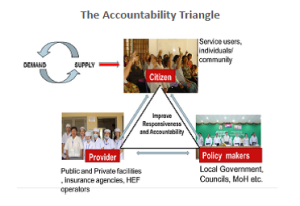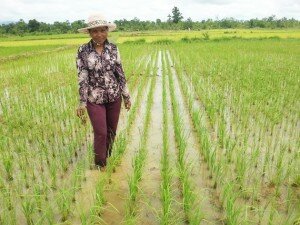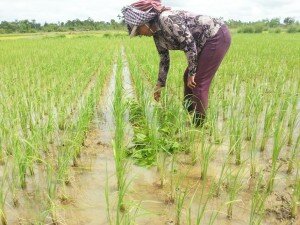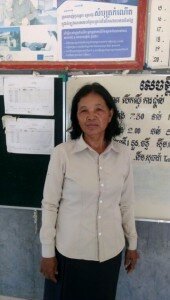Stronger Governance Improves Health Services in Cambodia
Kampong Kandal, Cambodia, January, 2016 – In Cambodia, community participation in health care services is paying off. A nationwide roll-out of Health Centre Management Committees (HCMC) are strengthening local governance and enhancing community participation in the health sector, Communities are now getting involved with the co-management of facilities and exchange of information among citizens, health care providers and local authorities leading to improved accountability and transparency, more efficient services and stronger leadership. More>>>
Stronger Governance Improves Health Services in Cambodia
Kampong Kandal, Cambodia, January, 2016 – In Cambodia, community participation in health care services is paying off. A nationwide roll-out of Health Centre Management Committees (HCMC) are strengthening local governance and enhancing community participation in the health sector, Communities are now getting involved with the co-management of facilities and exchange of information among citizens, health care providers and local authorities leading to improved accountability and transparency, more efficient services and stronger leadership.
“Cooperation is much better now,” said Hor Suon, Chief of the Kampong Kandal Health Centre. “For instance, we are now organising outreach activities together.”
Communities surrounding the health centre are experiencing improvements including funds allocated to their local commune budget, improved opening hours of health centre and patient-doctor relationships and more health education outreach and activities contributing to improved health centre hygiene. Health centre infrastructure has also improved including a wheel-chair accessible ramp, waiting room, and suggestion boxes.
The most recent Client Satisfaction Survey conducted in 2015 showed that patients treated in the health centre of Kampong Kandal were satisfied with the health services.
Our Approach: Health System Governance
Health System Governance teams provide technical advice to HCMCs in the province of Kampot, which is one of the project’s target provinces. The underlying approach to Health System Governance aims to enhance interactions between citizens, health providers and local authorities or policymakers (see Figure 1), improving health system governance at the sub-national level.
In 2012, one of the first HCMCs received support by the Health Service Governance team in Kampong Kandal commune. This committee was chosen in early 2012, since the members were struggling to fulfill their roles and responsibilities.
The Health System Governance team provides technical advice and facilitates committee meetings, which take place every second month. During the meetings, the team’s advisor Mr. Por Pen, assists in monitoring the performance of the health centre of Kampong Kandal and the implementation of agreed activities. He also ensures that feedback from patients is taken into consideration. Additionally, the Health System Governance team organises regular workshops and trainings to equip HCMC members with essential skills and knowledge. Governance teams provide training on how to interpret client satisfaction survey findings; client and provider rights and duties; and on-the-job training on how to manage HCMC meetings.
What are Health Centre Management Committees (HCMC)?
HCMCs aim to improve the scope and quality of services in health centres. Health centre staff are part of the committee as well as the chief and members of the commune council and members of the Village Health Support Group, who represent citizen’s interests. The main role of HCMCs is to provide direction and guidance for health centres to ensure that services are available, accessible and utilized.
Efficiency On The Rise
The work of the HCMC Kampong Kandal is now more efficient, since members know what is expected from them and they are aware of their rights and duties. It has been reported that communication and collaboration among citizens, health centre staff and the commune council have improved considerably. In general, all groups are now more actively involved in HCMC meetings, the planning processes for the health centre and the commune council, and reflection forums.
“The members of the committee are much more committed since we are receiving support from GIZ,” said Ty Vuthy Commune Council Chief. “Before, they did not show initiative.”
Story by Mrs. Kira Brings and Mr. Por Pen
Photo by Mrs. Kira Brings
![]()
From Housewife to Chief in Kampong Thom
13 January 2016
Kampong Thom, July 2015 – Yort Norng was living with her eight children and her husband, a soldier and the village chief of Samrong, Preah Damrei commune in a rural area in Kampong Thom. In 1986, her life drastically changed when her husband died.
Norng is highly motivated to improve the life of the villagers in Samrong village, “I really wanted to help my community,” she said enthusiastically.
Soon after this tragic event, her community chose her as the new village chief of Samrong, as they valued her strong engagement with the community.
Norng continued to serve her village as leader for 26 years before she was elected in 2012 as commune chief for her district in Preah Damer, Kampong Thom. More>>>
From Housewife to Chief in Kampong Thom
13 January 2016
Kampong Thom, July 2015 – Yort Norng was living with her eight children and her husband, a soldier and the village chief of Samrong, Preah Damrei commune in a rural area in Kampong Thom. In 1986, her life drastically changed when her husband died.
Norng is highly motivated to improve the life of the villagers in Samrong village, “I really wanted to help my community,” she said enthusiastically.
Soon after this tragic event, her community chose her as the new village chief of Samrong, as they valued her strong engagement with the community.
Norng continued to serve her village as leader for 26 years before she was elected in 2012 as commune chief for her district in Preah Damer, Kampong Thom.
As commune council chief, Norng assumes the highest responsibility in her district. She is eager to full the expectations of her community.
Norng recalls the risk one took to be politically engaged at that point in Cambodia’s history, “I put the list with the names of the committee members in a bamboo pole, to protect the paper, and buried it in my garden, as it was dangerous to be a committee member”.
With only a secondary school education, Norng is trained in sewing. It was not until later in her life that she assumed the responsibility as village chief. In addition to her current role as commune council chief, Norng is a member of several committees in the commune of Preah Damer including the Red Cross, Association Health and Rights and is a member of the Health Center Management Committee.
Additionally, Norng is a member of the Health Centre Management Committee (HCMC), supported by GIZ’s Social Health Protection Project. The overall aim of the HCMC is to improve the cooperation between citizens, health staff and government staff in order to improve health services provided by health centres. She uses her longstanding experience to facilitate this cooperation. Improving health and well-being of citizens’ living in her commune is one of her overarching objectives.
In 1995 a friend recommend that Norng contact the GIZ – then GTZ, to learn more about their rural development programmes. The same GTZ that eventually supported her village provided financial support to the Cash and Rice Association and provided technical advice for the elections of the Cash and Rice Association Committee.
Her initial contact with the GTZ was the start of a longstanding collaboration between her and the local GIZ team.
Norng participated in many GTZ/GIZ trainings to improve her leadership skills and apply her knowledge for the greater good of her village and later also for her commune. She is very grateful that she received support from GTZ/GIZ, as it helped her gain confidence for her political position.
“I gained a lot of knowledge thanks to GIZ trainings and it helped me fulfil my tasks,” said Norng. “I still benefit from them. Before I felt blind.”
Story by Nary Da and Mrs. Kira Brings
![]()
She is happy and proud (both at home and farm): A story of woman in Cambodia shows everyone has the rights to better livelihood

Ms. Him Sothea is an example of the woman who could change her life from nobody to a well-recognized organic rice farmer.
12 January 2016
Him Sothea, 49, a mother of three daughters, living in Chum Teavchreng Village, Tang Krous commune, Kampong Chhnang Province. Her older daughter is 21 years old, studying at university in Phnom Penh while the youngest is studying at grade 7 in the community. Ms. Sothea has been working in agricultural farming since she was young. Her parents and so do her grandparents were farmers. After her graduation at grade 6, she married and cultivated rice on one and a half hectares of land in the same way her ancestors had been doing.
“Before joining this project of CEDAC/GIZ, I was too shy to be in meeting. When attending the meeting people did not listen and pay attention to me while I was talking and sharing information. May be they see that I am poor and illiterate,” she said.
Since 2006, Ms. Sothea has participated in the CEDAC (The Cambodian Center for Study and Development in Agriculture) /GIZ (German International Cooperation) project where she could learn more about agriculture technique to improve production, and she was assigned as a leader of an organic rice producer group that requires a lot of time for the participants to be in the meetings, trainings, and various facilitation and monitoring activities while her husband was working at the field.
At that time, her husband was unhappy because a neighbor told him that women should not go out of a house to attend the meeting, or training. They should be at home for cooking and farming. But, this could not stop her from doing her out-of-the-house work. She started to share what she learnt from the meetings with her husband and it made him gradually understand and let her continue what she was doing.
In her normal days, Ms. Sothea wakes up at 4 am for cooking, doing home gardening, feeding pigs and cows and during rice production seasons doing some field works including ploughing, transplanting, harvesting and threshing on the family’s four hectare of land. During the day time in the production season, she only make time for 30-minute-rest while in the off production season she manages to have one hour rest. Right now, she has four hectares in total for organic agriculture.
From the surplus of family consumption, she makes 2,500 US dollar annually from selling organic rice with 15 percent above the conventional market price.
In the beginning, the villagers did not concern much about health care, sanitation and any input source for agriculture. They spent a lot of money for chemical fertilizer. But today things are getting better,” Ms. Sothea said.
The source of food for her daily consumption comes mostly from her own farm. From the surplus of family consumption, she makes 2,500 US dollar annually from selling organic rice with 15 percent above the conventional market price. Apart from agriculture, she earn 40 US dollar monthly from her part time job in rolling as a village statistical collector, women and children health and gender promoter at the village.
“In the beginning, the villagers did not concern much about health care, sanitation and any input source for agriculture. They spent a lot of money for chemical fertilizer. But today things are getting better,” she said.
In the family, she is mostly responsible in decision making. Her husband mostly leaves it to her as he does not want to deal with family related matters and only wants to work in the farm.
“My husband does not speak or communicate much with others or even me. He is not very active in farming activities and he drinks wine every day,” she said.

For her future plan, Ms. Sothea wants to scale up the organic production and apply biocontrol agents to her rice farming.
Through her own observation, men in the community do lesser activities associated with the immediate care and maintenance of the households such as children caring. Women are usually concerned with issues relating to family, health, food, child’s study and social work. In farming, she sees that women have the primary responsibility for the care and maintenance of the rice seed, livestock and home garden.
“I think women benefit directly from the CEDAC/GIZ training and meeting. I think men may see it is not important for them. However, the men are constantly updated about results of the trainings and meetings,” she said.
Ms. Sothea now knows very well about chemical pesticides which pollute water, soil quality, and beneficial insect and human health. She said recently a neighbor farmer in the village died at the field because he was not instructed well to use pesticides against insect crab in rice field. With this reason, she and some other farmers in the village stop using chemical pesticide. Instead, she uses compost, cow dung, field residue and green manure to fertile soil and natural pesticide to against insect.
“The villagers now feel confident on me and trust me on the information. They have seen that I have changed positively not only in terms of my livelihood, but also in terms of training facilitation, public speaking and social responsibility.”
For her future plan, Ms. Sothea wants to scale up the organic production and apply biocontrol agents in case there is any problem with soil borne and foliar disease in her farm. Ms. Sothea is an example of the woman who could change her life from nobody to be a well recognized organic rice farmer in the community through her activities in transferring the knowledge from the training to other farmers and improve various social contributions.
The training and meeting consists mainly female women participants who are acting as multipliers to transfer their gained knowledge to farmers and other cooperatives. Due to Based on the training, a survey analysis showeds that knowledge of female women farmers increases in terms of production techniques, biological plant protection as well as the usage of pesticides and organic cultivation methods. It also gaives awareness of the effects on the environment such as degradation and water pollution as well as the effects on human’s health by using chemicals and pesticides. The study also showeds that women got empowered through capacity development measures provided by the CEDAC/GIZ project. The acquired knowledge increased the self-confidence and the role of women in the agricultural sector and in society. Besides, the confidence of women increased in terms of public speaking, social responsibility and decision making capacity in family.
The CEDAC/GIZ project in Cambodia promotes organic cultivation among farmers in the country. It trains farmers in implementing biological plant protection based on Trichoderma fungi, a specific form of biological plant protection. In cooperation with the USAID project HARVEST, the aim is to improve the yield in rice and vegetables of a total of 500 smallholder farmers. About 6,000 could be reached indirectly.
By Channa Samorn, ASEAN Sustainable Agrifood Systems
![]()



